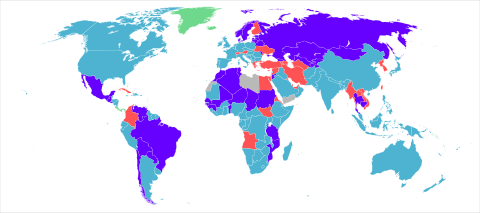
| Part of a series on |
| War (outline) |
|---|
 |
| Part of a series on |
| Forced labour and slavery |
|---|
 |
Conscription, also known as the draft in American English, is the practice in which the mandatory enlistment in a national service, mainly a military service, is enforced by law.[1] Conscription dates back to antiquity and it continues in some countries to the present day under various names. The modern system of near-universal national conscription for young men dates to the French Revolution in the 1790s, where it became the basis of a very large and powerful military. Most European nations later copied the system in peacetime, so that men at a certain age would serve 1 to 8 years on active duty and then transfer to the reserve force.
Conscription is controversial for a range of reasons, including conscientious objection to military engagements on religious or philosophical grounds; political objection, for example to service for a disliked government or unpopular war; sexism, in that historically men have been subject to the draft in the most cases; and ideological objection, for example, to a perceived violation of individual rights. Those conscripted may evade service, sometimes by leaving the country,[2] and seeking asylum in another country. Some selection systems accommodate these attitudes by providing alternative service outside combat-operations roles or even outside the military, such as siviilipalvelus (alternative civil service) in Finland and Zivildienst (compulsory community service) in Austria and Switzerland. Several countries conscript male soldiers not only for armed forces, but also for paramilitary agencies, which are dedicated to police-like domestic-only service like internal troops, border guards or non-combat rescue duties like civil defence.
As of 2023, many states no longer conscript their citizens, relying instead upon professional militaries with volunteers. The ability to rely on such an arrangement, however, presupposes some degree of predictability with regard to both war-fighting requirements and the scope of hostilities. Many states that have abolished conscription still, therefore, reserve the power to resume conscription during wartime or times of crisis.[3] States involved in wars or interstate rivalries are most likely to implement conscription, and democracies are less likely than autocracies to implement conscription.[4] With a few exceptions, such as Singapore and Egypt, former British colonies are less likely to have conscription, as they are influenced by British anti-conscription norms that can be traced back to the English Civil War; the United Kingdom abolished conscription in 1960.[4]
- ^ "Conscription". Merriam-Webster Online. 13 September 2023.
- ^ "Seeking Sanctuary: Draft Dodgers". CBC Digital Archives.
- ^ "World War II". The Canadian Encyclopedia. Toronto: Historica Canada. 15 July 2015.
- ^ a b Asal, Victor; Conrad, Justin; Toronto, Nathan (2017-08-01). "I Want You! The Determinants of Military Conscription". Journal of Conflict Resolution. 61 (7): 1456–1481. doi:10.1177/0022002715606217. ISSN 0022-0027. S2CID 9019768.
